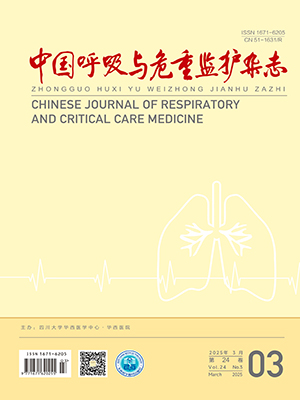Objective To determine if the levels of high-sensitivity C-reactive protein ( hs-CRP)and fibrinogen ( Fbg) can predict the risk of acute exacerbation of chronic obstructive pulmonary disease ( COPD) . Methods hs-CRP was measured by latex-enhanced immunoturbidimetric assay and Fbg was assessed by Von Clauss method. The number of exacerbations was recorded during a 6-month follow-up period. Results Fifty patients with stable COPD were enrolled in the study, of whom48 patients completed the trial and two patients dropped out. During the follow-up, 16 patients had once or more acute exacerbations while other 32 patients had no acute exacerbation. The patients were stratified into two groups ( A-exacerbation, B-no exacerbation) . At the baseline, the patients of the group A had lower FEV1 than the
group B [ ( 1. 1 ±0. 4) L vs. ( 1. 4 ±0. 5) L, P lt;0. 05] . And the group A had higher hs-CRP and Fbg than the group B [ hs-CRP: ( 4. 6 ±3. 3) mg/L vs. 4. 3 mg/L( IQR 5. 5 mg/L) , P lt;0. 05] ; Fbg: ( 3. 8 ±0. 7) g/L vs. ( 3. 1 ±0. 5) g/L, P lt;0. 05] . Nine of 16 patients with a higher level of hs-CRP( hs-CRP gt;3 mg/L) had acute exacerbations. Seven of other 32 patients with normal hs-CRP level had acute exacerbations. The difference in the acute exacerbations rate between the two groups was significant ( 56. 25% vs. 21. 88% , P lt;0. 05) . All four patients with a higher level of Fbg( Fbg gt;4 g/L) had acute exacerbations. Twelve of 44 patients with normal Fbg level ( Fbg≤4 g/L) had acute exacerbations. The patients with Fbg more than 4 g/L had a higher rate of acute exacerbations( 100% vs. 27. 27%, P lt;0. 05) . After adjusting by age, body
mass index ( BMI) , FEV1 , tobacco consumption and other chronic diseases, the risk of acute exacerbation in individuals with baseline hs-CRP gt;3 mg/L was 9. 33 times higher than those with baseline hs-CRP≤3 mg/L ( 95% CI 1. 870-46. 573) . Conclusion Higher level of hs-CRP is associated with the high risk of exacerbation in patients with COPD.
Citation: NIE Shan,WANG Haoyan,XU Qiufen,HE Xin,GUO Tong,YANG Xiaoli,ZHAO Xujuan. Increased High-Sensitivity C-Reactive Protein Is a Risk Predictor for Acute Exacerbations of Chronic Obstructive Pulmonary Disease. Chinese Journal of Respiratory and Critical Care Medicine, 2011, 10(2): 116-120. doi: Copy
Copyright © the editorial department of Chinese Journal of Respiratory and Critical Care Medicine of West China Medical Publisher. All rights reserved




